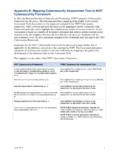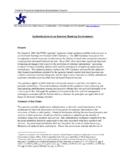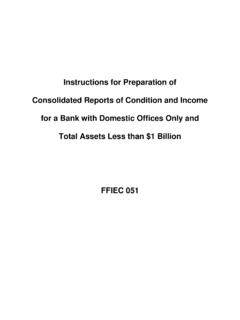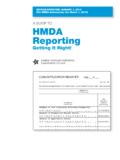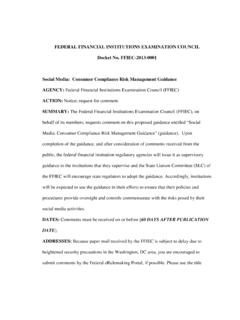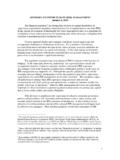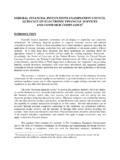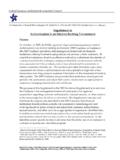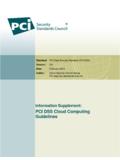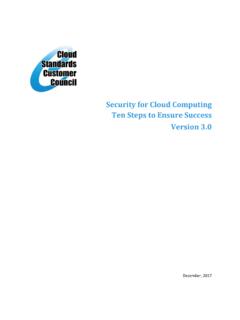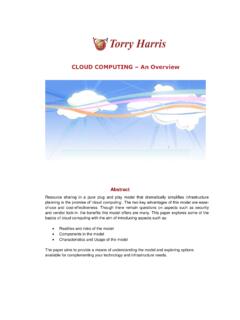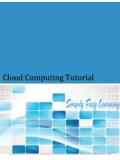Transcription of Joint Statement Security in a Cloud Computing Environment ...
1 Joint Statement Security in a Cloud Computing Environment INTRODUCTION. The Federal Financial Institutions Examination Council (FFIEC) on behalf of its members 1 is issuing this Statement to address the use of Cloud Computing 2 services and Security risk management principles in the financial services sector. Financial institution management should engage in effective risk management for the safe and sound use of Cloud Computing services. Security breaches involving Cloud Computing services highlight the importance of sound Security controls and management's understanding of the shared responsibilities between Cloud service providers and their financial institution clients. This Statement does not contain new regulatory expectations; rather, this Statement highlights examples of risk management practices for a financial institution's safe and sound use of Cloud Computing services and safeguards to protect customers' sensitive information from risks that pose potential consumer harm.
2 Management should refer to the appropriate FFIEC member guidance referenced in the Additional Resources section of this Statement for information regarding supervisory perspectives on effective information technology (IT) risk management practices. This Statement also contains references to other resources, including the National Institute of Standards and Technology (NIST), National Security Agency (NSA), Department of Homeland Security (DHS), International Organization for Standardization (ISO), Center for Internet Security (CIS), and other industry organizations ( , Cloud Security Alliance). BACKGROUND. Due diligence and sound risk management practices over Cloud service provider relationships help management verify that effective Security , operations, and resiliency controls are in place and consistent with the financial institution's internal standards.
3 Management should not assume that effective Security and resilience controls exist simply because the technology systems are operating in a Cloud Computing 1. The FFIEC comprises the principals of: the Board of Governors of the Federal Reserve System, Bureau of Consumer Financial Protection, Federal Deposit Insurance Corporation, National Credit Union Administration, Office of the Comptroller of the Currency, and State Liaison Committee. 2. NIST SP 800-145, The NIST Definition of Cloud Computing : Recommendations of the National Institute of Standards and Technology, defines Cloud Computing as a model for enabling ubiquitous, convenient, on-demand network access to a shared pool of configurable Computing resources ( , networks, servers, storage, applications, and services) that can be rapidly provisioned and released with minimal management effort or third-party service provider interaction.
4 Environment . The contractual agreement between the financial institution and the Cloud service provider should define the service level expectations and control responsibilities for both the financial institution and provider. Management may determine that there is a need for controls in addition to those a Cloud service provider contractually offers to maintain Security consistent with the financial institution's standards. Ongoing oversight and monitoring of a financial institution's Cloud service providers are important to gain assurance that Cloud Computing services are being managed consistent with contractual requirements, and in a safe and sound manner. This oversight and monitoring can include evaluating independent assurance reviews ( , audits, penetration tests, and vulnerability assessments), and evaluating corrective actions to confirm that any adverse findings are appropriately addressed.
5 Risk management expectations for the management of relationships involving third parties (such as third- party Cloud Computing services) are outlined in FFIEC members' respective guidance and the Information Security Standards. 3. Cloud Computing environments are enabled by virtualization 4 technologies, which allow Cloud service providers to segregate and isolate multiple clients on a common set of physical or virtual hardware. Financial institutions use private Cloud Computing environments, 5 public Cloud Computing environments, 6 or a hybrid of the two. NIST generally defines three Cloud service models. 7 For each service model, there are typically differing shared responsibilities between the financial institution and the Cloud service provider for implementing and managing controls.
6 These models and the typical responsibilities include: Software as a Service (SaaS) is similar to traditional outsourcing in which the software applications (applications) operate on the provider's Cloud infrastructure. In this model, financial institution management does not typically manage, maintain, or control the underlying Cloud infrastructure or individual application capabilities. The financial institution is responsible for user-specific application configuration settings, user access and identity management, and risk management of the relationship with the Cloud service provider. The Cloud service provider is responsible for any changes to and maintenance of the applications and infrastructure.
7 Platform as a Service (PaaS) is a model in which a financial institution deploys internally developed or acquired applications using programming languages, libraries, services, and tools supported by the Cloud service provider. These applications reside on the provider's platforms 3. A financial institution's overall information Security program must also address the specific information Security requirements applicable to customer information set forth in the Interagency Guidelines Establishing Information Security Standards implementing section 501(b) of the Gramm Leach Bliley Act and section 216 of the Fair and Accurate Credit Transactions Act of 2003. See 12 CFR 30, appendix B (OCC); 12 CFR part 208, appendix D-2, and 12 CFR part 225, appendix F (FRB); 12 CFR 364, appendix B (FDIC); and 12 CFR 748, appendix A (NCUA) (collectively referenced in this Statement as the Information Security Standards ).
8 4. The NIST Glossary defines virtualization as the simulation of the software and/or hardware upon which other software runs. 5. The NIST Glossary defines private Cloud Computing as The Cloud infrastructure is provisioned for exclusive use by a single organization comprising multiple consumers ( , business units). It may be owned, managed, and operated by the organization, a third party, or some combination of them, and it may exist on or off premises.. 6. The NIST Glossary defines public Cloud Computing as The Cloud infrastructure is provisioned for open use by the general public. It may be owned, managed, and operated by a business, academic, or government organization, or some combination of them.
9 It exists on the premises of the Cloud provider.. 7. NIST SP 800-145, The NIST Definition of Cloud Computing . Page 2 of 11. and Cloud infrastructure. PaaS models necessitate similar risk management as the SaaS model. However, management is also responsible for appropriate provisioning and configuration of Cloud platform resources and implementing and managing controls over the development, deployment, and administration of applications residing on the provider's Cloud platforms. The Cloud service provider is responsible for the underlying infrastructure and platforms (including network, servers, operating systems, or storage). Infrastructure as a Service (IaaS) is a model in which a financial institution deploys and operates system software, including operating systems, and applications on the provider's Cloud infrastructure.
10 Like PaaS, the financial institution is responsible for the appropriate provisioning and configuration of Cloud platform resources and implementing and managing controls over operations, applications, operating systems, data, and data storage. Management may need to design the financial institution's systems to work with the Cloud service provider's resilience and recovery process. Also, as in the other models, the financial institution is responsible for risk management of the relationship with the Cloud service provider. The Cloud service provider is responsible for controls related to managing the physical data center. For example, the Cloud service provider updates and maintains the hardware, network infrastructure, environmental controls ( , heating, cooling, and fire and flood protection), power, physical Security , and data communications connections.
